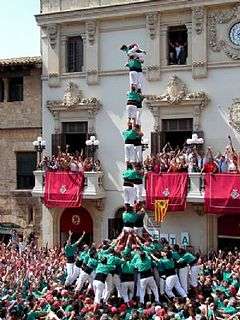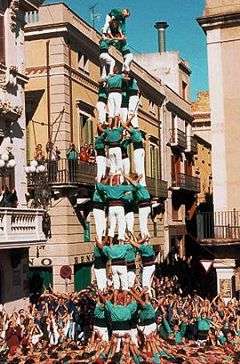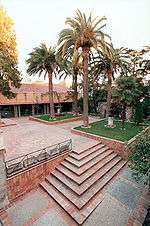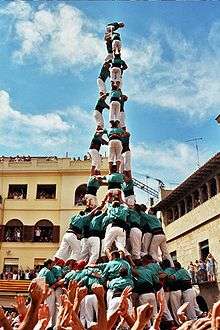Castellers de Vilafranca




The Castellers de Vilafranca (Catalan pronunciation: [kəstəˈʎez ðə βiɫəˈfɾaŋkə]) is a cultural and sporting association whose main objective is to build castells (human towers). It has the status of a public-interest association. The group was founded in 1948[1] in response to the increased interest in human tower building in Vilafranca del Penedès, a Catalan tradition that has evolved since the 18th century[2][3] Ball de Valencians, a dance from Valencia.
Nowadays, the Castellers de Vilafranca have about 400 active human tower building members of all ages,[4] with no discrimination on the grounds of race, religion, sex or social status. They share the common goal of building human towers, democratic values, cooperation and teamwork, a constant desire to surpass themselves, and a will to maintain a lead over a select and competitive group of rival human tower associations. The group’s headquarters is Cal Figarot, Casa Via Raventós, a house located in downtown Vilafranca del Penedès and specially adapted for human tower building activity (for example, high, indoor ceilings for winter use and an open-air courtyard for spring, summer and fall).
The group is one of the most important organizations in Vilafranca del Penedès and has represented Catalan culture abroad numerous times. The association has more than five hundred official supporters, and has the support of several public and private institutions. In addition to hosting and participating in human tower exhibitions, it also organizes other cultural activities, such as small-scale concerts, a poetry contest, a massive bicycle event, a dominoes tournament, food events and a human tower school for kids. The Castellers de Vilafranca’s efforts to preserve and promote popular Catalan culture have been recognized by the town of Vilafranca del Penedès, which awarded the group with the Medalla de la Vila (the town medal), and by the Generalitat de Catalunya (the Catalan Government) with the Creu de Sant Jordi (Cross of Saint George).
History

The Castellers de Vilafranca cultural association was founded in September 1948 by Oriol Rossell, who became the first cap de colla (Leader/Technical Manager of the group). The group successfully started with seven-level towers, and also forged close relationships with casteller groups in other towns. The first caps de colla were Oriol Rossell (1948–1952) and Ramon Sala (1953–1955). The group originally wore rose-coloured shirts, and subsequently, red ones. In 1956, the group became almost inactive due to internal disagreements and disputes. In 1957, it reorganized and elected to wear green shirts, which is still the distinctive colour used by the group today. From 1957 to 1968, seven-level towers were the norm, and the cinc de set was the highest tower achieved. From 1969 to 1974, the group improved considerably, building the first towers in the eight-level category: the torre de Set, quatre de vuit, tres de vuit, pilar de sis, and the torre de vuit amb folre. In 1972, the group won the Concurs de castells de Tarragona, the Human Towers Competition held biennially in Tarragona city in the south of Catalonia. During those years, the caps de colla were Josep Pedrol (1957–1959), Carles Domènech (1960–1961), Joan Bolet (1962–1963), Gabi Martínez (1964–1969), Lluís Giménez (1970–1973) and Gabi Martínez, again (1974).
In 1975, the group went through major internal restructuring, shifting from the very personal and almost-exclusive leadership of the cap de colla to management of the technical side of tower-building by a consensual team. 1981 brought with it more internal changes, and it was decided that team members would no longer be individually paid. This provoked a division in the group. From 1975 to 1982, eight-level towers were performed frequently but with difficulties. In 1983 and 1984, the group regained its strength in this category and, in 1985, it built the first cinc de vuit. This landmark achievement proved merely to be a milestone on the way to even more impressive nine-level towers. In 1987, the first tres and quatre de nou amb folre (carregat) arrived, and in 1989 the first completely successful tres de nou amb folre (descarregat) was achieved. Similar success came in 1990 with the first quatre de nou amb folre (descarregat). The cap de colla between 1975 and 1994 was Carles Domènech.
Between 1995 and 2004, the group enjoyed its most successful years to date. During this period, the highest and most difficult towers were achieved: descarregats (completely and successfully dismantled) the torre de nou amb folre i manilles, pilar de set amb folre, pilar de vuit amb folre i manilles (the first one in the 20th century), quatre de vuit amb l’agulla (the first one in the 20th century), quatre de nou amb folre i l’agulla (the first one in human tower history), cinc de nou amb folre, and tres and quatre de nou amb folre built simultaneously (the first - and only - time in human tower history). There were other successes, too. As for towers that were “only” carregats (reached the top but collapsed afterwards): the torre de vuit (the first one in the 20th century); quatre de nou, and the tres de deu amb folre i manilles (the first one in human towers history). The group also won the Tarragona Human Towers Competition in 1996, 1998, 2002, 2004 and 2006. In 2005 Castellers de Vilafranca achieved the torre de nou amb folre, which is considered the most difficult tower ever done by any group to date.
Francesc Moreno "Melilla" was the cap de colla between 1995 and 2003, and Lluís Esclassans from 2004 to 2007. David Miret was elected the new cap de colla in December 2007.
Castells achieved
Castellers de Vilafranca have achieved in their history most of the constructions that have been seen in any performance. You will find below the detailed list of human constructions and the date in which they were topped or dismantled for the first time :
| CASTELL | Descarregat (successfully dismantled) |
Carregat (collapsed in dismantling) |
| Tres de nou amb folre i agulla | 31 Aug 2009 | |
| Torre de nou amb folre | 30 Aug 2005 | |
| Tres de deu amb folre i manilles | 15 Nov 1998 | |
| Quatre de nou amb folre i tres de nou amb folre simultanis | 31 Aug 2001 | |
| Torre de vuit neta | 1 Nov 2010[5] | 1 Nov 1999 |
| Quatre de nou | 1 Nov 2002 | |
| Quatre de nou amb folre i agulla | 1 Nov 1996 | 1 Nov 1995 |
| Cinc de nou amb folre | 1 Nov 1997 | 30 Aug 1997 |
| Pilar de vuit amb folre i manilles | 28 Sep 1997 | 31 Aug 1995 |
| Torre de nou amb folre i manilles | 30 Aug 1995 | |
| Tres de nou amb folre | 30 Aug 1989 | 31 Aug 1987 |
| Quatre de nou amb folre | 1 Nov 1990 | 1 Nov 1987 |
| Quatre de vuit amb l'agulla | 8 Oct 1995 | |
| Cinc de vuit | 30 Aug 1985 | |
| Torre de vuit amb folre i pilar de set amb folre simultanis | 31 Aug 2006 | |
| Pilar de set amb folre | 1 Oct 1995 | 14 May 1995 |
| Tres de vuit amb agulla | 29 Aug 1996 | |
| Dos pilars de sis simultanis (un de carregat) | 31 Aug 2001 | |
| Torre de vuit amb folre | 17 Nov 1974 | 12 Oct 1973 |
| Tres de vuit | 30 Aug 1974 | 1 Oct 1972 |
| Pilar de sis | 30 Aug 1972 | 19 Dec 1971 |
| Quatre de vuit | 30 Aug 1971 | 12 Oct 1969 |
| Nou de set | 11 Dec 1988 | |
| Torre de set | 24 Aug 1969 | |
| Tres de set aixecat per sota | 25 Nov 1973 | |
| Sis de set | 21 Jan 1997 | |
| Cinc de set amb agulla | 19 Apr 2008 | |
| Cinc de set | 26 Sep 1965 | 30 Aug 1965 |
| Tres de set amb l'agulla | 10 Aug 1996 | |
| Quatre de set amb l'agulla | 5 Aug 1954 | 31 Aug 1953 |
| Tres de set | 31 Aug 1949 | |
| Quatre de set | 31 Aug 1949 | |
| Torre de sis | 16 Jun 1949 | |
| Pilar de cinc | 14 Sep 1948 |
Organization

According to the general organization of the group, management is divided into two main bodies - a technical one (Technical Committee or simply called la Tècnica), and an administrative one (Board Committee).
The Technical Committee is in charge of all aspects of human tower construction. The cap de colla has the most responsibility as he is the head of the tower-building side of the association. He is advised, supported and helped by a team composed of the sotscap de colla (vice-cap de colla) and two technical advisors. Three other teams depend on this core: the canalla team (responsible for the kids that crown the towers), the pinyes, folres and manilles team (responsible for the first, second and third bases), and the medical team. Each of them is also responsible for logistics, technical information and physical training, respectively.
The Board Committee is in charge of the administration of the group. While it oversees and manages the group’s assets, the committee members' primary responsibility is to represent the group externally to the community, the media and other organizations. Within the board, the president has the most responsibility. The secretary and the five vice-presidents are answerable to him, and each of them is responsible for a specific area: social activities, treasurer, liaising with the public authorities, maintenance of Cal Figarot and marketing and media. The group also has three advisory councils: international relations, legal service and a council of elders.
Organization chart

Technical Committee
- Cap de colla: David Miret i Rovira
- Vicecap de colla: Toni Bach i Lleal
- Technical Assistants: Jordi Colomera i Salla, Joan Badell i Roses
Board Committee
- President: Andrew J. Vogl i Miralles
- Secretary: Joan Vendrell i Olivella
- Social Activities Vice President: Àlex Sánchez-Granados
- Treasury Vice President: Miquel Ropero i Ventosa
- Public Authorities Relations Vice President: Xavier Escribà i Vivó
- Maintenance of Cal Figarot Vice President: Joan Mestres i Arnan
- Marketing and Media Vice President: Francesc Bou i Pijoan
Advisory Councils
- International Relations
- Legal Adviser Team
- Council of Elders
Cal Figarot, the group's headquarters

Cal Figarot is the group's headquarters. The neogothic-style building, built by August Font de Carreres at the end of the 19th century, was acquired in 1983. An adjacent warehouse was bought in 1998, and both buildings were renovated to better suit the group's needs. The warehouse has an interior open space of 600 square metres. The most important space is the courtyard, where the training sessions take place.
Castellers de Vilafranca in the world

The Castellers de Vilafranca have been one most international human tower group. They have performed in:
- in France, during the festival of the newspaper ‘L'Humanité’, Paris (1973).
- in Switzerland, during the Quinzena Catalana (Catalan forthnight) in Geneva (1978).
- on the Italian island of Sardinia (1978), with performances in Alghero and Sassari.
- in Portugal (1982), with performances in Lisbon, Sintra, Estoril, Coimbra and Porto.
- in Italy (1984), where the group performed in Pisa, Siena, Rome, the Vatican City and Florence.
- in Béziers, France (1987).
- in Italy (1988), during the celebration of the thousandth anniversary of Catalonia, performing in Pisa, Vatican City and Roma.
- in the Basque Country (1990), where the group performed in Bergara, Antzuola, Zumarraga and Urretxo.
- in Italy (1990), in the north: Feltre (palio), Niccia and Melere (in the municipality of Trichiana) and Venice.
- again in France (1991), with performances in Toulouse, during the Sardana International Festival, and Carcassonne.
- in Luxemburg and Germany (1991), performing in Luxemburg (capital), Moers, Wolfenbütel, Hannover, Berlin and Frankfurt.
- in the Universal Exposition Seville'92 (1992), during the Catalonia day.
- in Santiago de Compostella (1993), in the framework of the Xacobeo'93.
- in the same year, the group did a tour of five countries: France (Marseille), Italy (Lecco, Melzo and Bergamo), Slovenia (Ljubljana, Postojna, Otocêc, Novo Mesto and Crnomêlj), Austria (Klagenfurt) and Monaco.
- again in Paris and in Poix de Picardie, France (1993).
- in Italy for the fifth time, with performances in Venice (Carnival) and Mestre, and France (Villeurbanne and Lyon) in 1994.
- in Netherlands and Belgium (1994), performing in Amsterdam, Enschede, Aalten, Almelo, Emmen and Brussels.
- in Navarra (1995), performing in Tudela.
- in Denmark (1996), in Copenhagen and Holte.
- the same year in France (Metz), Netherlands (Maastricht) and Belgium (Bree).
- in Sobradiel (1999), Aragon.
- in Bühl, twin city of Vilafranca del Penedès (2002).
- in Salamanca (2002).
- again in France (2004), where they performed in Dunkirk.
- in the Basque Country (2005), with performances in Donostia and Elorrio.
- in France (2006), where they performed in Steenvoorde.
- again in Aragón (2006), in the festival of Binèfar.
- in 2007 they performed in Germany, during the Frankfurt Book Fair.
- in January 2008 they performed in Chile, which was the first performance of a Catalan human tower group in the southern hemisphere.[6] In 2010 they returned to Chile, to Valparaíso[7]
- in Brussels, Belgium (2010) supporting the nomination of Castells to UNESCO Heritage.[4]
- in India (2011), meeting the Govindas.[8][9]
- in New York City (2012).
- The Castellers de Vilafranca also performed in the opening ceremony of the XXV Olympic Games in Barcelona in 1992, which has been undoubtedly the most watched human tower performance worldwide.
- The group also performed during the world presentation of the latest novel by Noah Gordon "The bodega" held in Vilafranca del Penedès (2007).[10]
The Castellers de Vilafranca have also spread the human tower tradition in the Països Catalans (territories in which the varieties of Catalan are traditionally spoken):
- Performances in Northern Catalonia: six times in Perpignan (1970, 1977, 1982 [in the festival of the Union Sportive des Arlequins Perpignanais, USAP], 1989 [Mules Festival], 1997 and 1998), in Toluges (1970), during the Peace Festival, in Collioure (1984), in Banyuls de la Marenda (1986), three times in Vilafranca de Conflent (1985, 1988 i 1989), in the Saint Michel de Cuxa monastery (1985), Prada de Conflent [in the Catalan Summer University and the town] (1988) and in Baó, in the framework of the First meeting of the catalanitat in North Catalonia (2002).
- Four times in Andorra: in Encamp (1971), Andorra la Vella and Sant Julià de Lòria (1976) [during the Catalan Culture Congress], in Escaldes and again in Andorra la Vella (1983) and Escaldes (1985).
- Two tours in the Valencia Region: the first one in Ribera del Xúquer (1979), with performances in Carcaixent, the Aigües Vives monastery, Sueca, Cullera, Algemesí and a pilar de cinc in front of the home of Raimon (one of the most well-known veteran artists in the Catalan language), in Xàtiva; the second one (1981) the group performed in Alcoi, Benidorm and Alicante. Subsequently they performed in Carcaixent (1985), Algemesí (1993 and 2000), Castellón (2000) [13a Festa de la Llengua], Olleria and Benicarló (in the Valencian Region Day).
- One tour in Palma, Majorca (1980) and Manacor, Menorca (2001).
- One tour, already mentioned, in Alghero (1978).
Victories in Tarragona's Human Towers Competition
Castellers de Vilafranca have won the Concurs de castells de Tarragona (Human Towers Competition) eight times:
- VII Tarragona's Human Towers Competition, 1972
- XVI Tarragona's Human Towers Competition, 1996
- XVII Tarragona's Human Towers Competition, 1998
- XIX Tarragona's Human Towers Competition, 2002
- XX Tarragona's Human Towers Competition, 2004[11]
- XXI Tarragona's Human Towers Competition, 2006[12]
- XXII Tarragona's Human Towers Competition, 2008[13]
- XXIII Tarragona's Human Towers Competition, 2010[14][15]
- XXIV Tarragona's Human Towers Competition, 2012
Gallery
 First quatre de vuit carregat by the Castellers de Vilafranca, 12/10/1969
First quatre de vuit carregat by the Castellers de Vilafranca, 12/10/1969 First tres de nou descarregat by the Castellers de Vilafranca, 30/08/1989
First tres de nou descarregat by the Castellers de Vilafranca, 30/08/1989 First pilar de vuit descarregat in history, Castellers de Vilafranca, 28/09/1997
First pilar de vuit descarregat in history, Castellers de Vilafranca, 28/09/1997 First torre de vuit sense folre carregada in history, Castellers de Vilafranca, 1/11/1999
First torre de vuit sense folre carregada in history, Castellers de Vilafranca, 1/11/1999 First pilar de vuit amb folre i manilles descarregat in Barcelona, Castellers de Vilafranca, 25/09/2005
First pilar de vuit amb folre i manilles descarregat in Barcelona, Castellers de Vilafranca, 25/09/2005 First torre de vuit amb folre and pilar de set amb folre descarregats simultaneously in history, Castellers de Vilafranca, 31/08/2006
First torre de vuit amb folre and pilar de set amb folre descarregats simultaneously in history, Castellers de Vilafranca, 31/08/2006 Tres de deu amb folre i manilles by the Castellers de Vilafranca
Tres de deu amb folre i manilles by the Castellers de Vilafranca Torre de set in Pisa, Castellers de Vilafranca, 1988
Torre de set in Pisa, Castellers de Vilafranca, 1988 Torre de set in Paris, Castellers de Vilafranca, 1993
Torre de set in Paris, Castellers de Vilafranca, 1993 Pilar de sis in Copenhaguen, Castellers de Vilafranca, 1996
Pilar de sis in Copenhaguen, Castellers de Vilafranca, 1996
References
- ↑ "Història dels Castellers de Vilafranca" (in Catalan).
- ↑ "Photography exhibition on Catalan human towers commemorates their first anniversary as part of World Cultural Heritage". Catalan News Agency. 17 November 2011.
- ↑ "Close-Up: Catalonia's human towers". BBC. 14 November 2010.
- 1 2 "Un grupo de castellers viste con su atuendo al Manneken Pis de Bruselas" (in Spanish). La Vanguardia. 9 October 2010.
- ↑ "Els Castellers de Vilafranca descarreguen la 'bèstia indomable'" (in Catalan). Vilaweb. 1 November 2010.
- ↑ ""Castellers" de Vilafranca declaran a Chile "plaza castellera" de Latinoamérica" (in Spanish). El Mercurio. 21 January 2008.
- ↑ "Els Castellers de Vilafranca viatjaran a Xile per participar al Fòrum Universal de Cultures de Valparaíso" (in Catalan). 324.cat. 16 November 2010.
- ↑ "Catalan human towers embark on an educational trip to India". Catalan News Agency. 17 August 2011.
- ↑ "Los Castellers de Vilafranca, impactantes torres humanas, se presentarán este lunes en La Serena" (in Spanish). La Voz del Norte. 5 December 2010.
- ↑ "Noah Gordon escriu una carta d'amor a Catalunya i el món del vi en la seva última novel·la" (in Catalan). Catalonia Television. 22 October 2007.
- ↑ "Els Castellers de Vilafranca revaliden el títol de campions del concurs de Tarragona" (in Catalan). Vilaweb. 4 October 2004.
- ↑ "Els Castellers de Vilafranca s'imposen per tercer cop consecutiu en el concurs de castells de Tarragona" (in Catalan). Catalan Television. 2 October 2006.
- ↑ "Els Castellers de Vilafranca revaliden el títol del concurs de Tarragona amb una actuació històrica" (in Catalan). Catalan Television. 5 October 2008.
- ↑ "Els Castellers de Vilafranca tornen a fer història" (in Catalan). Vilaweb. 3 October 2010.
- ↑ "Els Castellers de Vilafranca guanyen el Concurs de Castells de Tarragona després de fer tres castells de gamma extra" (in Catalan). Catalan Television. 4 October 2010.
External links
| Wikimedia Commons has media related to Castellers de Vilafranca. |